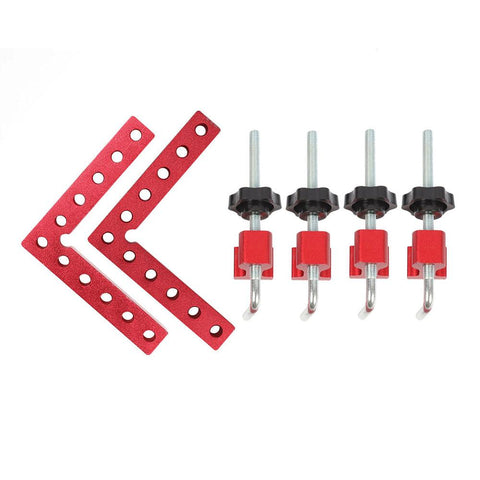Gundecha Industrial Complex, Kandivali East, Mumbai - 400101
Bit Steps: Revolutionizing Precision Drilling for Every Project

In the expansive world of woodworking and metalworking, clamps are essential tools, crucial for holding materials in place to ensure precision and safety. Among the many types of clamps available, one stands out as the most common and versatile - the bar clamp. Also known as an F-clamp or sliding clamp, the bar clamp has become a staple in workshops and garages across the world due to its ease of use, adaptability, and reliability.
A bar clamp consists of a sturdy metal bar with two adjustable jaws: one fixed and one that slides along the bar. This adjustable jaw allows the clamp to accommodate materials of various sizes, making it a go-to choice for projects both large and small. The sliding jaw is equipped with a tightening screw, which applies pressure to the workpiece, holding it securely in place. This simple yet highly effective design allows the bar clamp to be used in a wide range of applications, from securing pieces of wood for gluing to holding metal sheets during welding.
One of the reasons the bar clamp is so widely used is its ability to apply a significant amount of pressure evenly across the workpiece. When joining two pieces of wood, for example, it is crucial that the bond is tight and that the glue sets without gaps or misalignment. Bar clamps are especially effective in these situations because they can span a larger area than smaller clamps, ensuring that long pieces of wood are held securely. This even distribution of pressure helps to create strong, seamless joints, which are essential for the structural integrity of any woodworking project.
In furniture making, bar clamps are indispensable. Whether assembling a chair, table, or bookshelf, the precise alignment of parts is key to producing a sturdy and aesthetically pleasing final product. Bar clamps allow the woodworker to hold components in perfect alignment while screws, nails, or dowels are added to secure them. They can also be used to hold glued joints together while the adhesive cures, ensuring a strong, durable bond. For large-scale projects, such as cabinet making, bar clamps are invaluable because they can stretch across the width or height of the piece, keeping all parts in place during the assembly process.
Another advantage of the bar clamp is its ease of adjustment. Because the sliding jaw can move freely along the bar, it is quick and simple to adjust the clamp to fit the size of the workpiece. This makes it incredibly versatile for projects that involve materials of varying thicknesses and dimensions. Whether working with thick slabs of wood or thin metal sheets, the bar clamp can be quickly adapted to hold the work securely. This flexibility makes it a favorite tool not only among professional woodworkers but also among hobbyists and DIY enthusiasts.
Bar clamps are also favored in metalworking, where holding parts steady is just as critical as it is in woodworking. In welding or fabricating metal structures, it's essential that pieces are held together precisely during the welding process. Any movement or misalignment can weaken the weld and compromise the strength of the finished product. The bar clamp's ability to maintain a firm grip on the material ensures that the welding is done with accuracy, leading to stronger, cleaner results. The clamp's long reach and strong grip make it particularly useful when working with large or heavy metal pieces.
Although bar clamps are incredibly useful, like any tool, they require proper handling to avoid damage to both the tool and the material being worked on. Applying too much pressure with a bar clamp can crush delicate materials or cause warping in softer woods. To prevent this, many woodworkers use pads or scrap pieces of wood between the clamp jaws and the workpiece to distribute the pressure more evenly and protect the surface. Additionally, choosing the correct size of bar clamp for the project is important - using a clamp that is too small can lead to insufficient pressure, while one that is too large may be cumbersome and difficult to control.
The bar clamp's design has evolved over the years, with modern versions offering features such as quick-release levers and ergonomic handles for easier use. These innovations have made the tool even more accessible to both professionals and beginners alike, reducing the amount of time and effort needed to secure materials. With these advancements, bar clamps have only grown in popularity, solidifying their place as the most common clamp used in a variety of tasks.
While there are many different types of clamps available, ranging from C-clamps to pipe clamps to spring clamps, none offer the same combination of versatility, strength, and ease of use as the bar clamp. Its ability to hold materials firmly, apply even pressure, and adjust quickly makes it the first choice for woodworkers and metalworkers alike. Whether you're building furniture, welding metal frames, or working on home repairs, the bar clamp will likely be the tool you reach for time and again.
In every workshop, the bar clamp serves as an unsung hero, quietly ensuring that projects are completed with precision and care. Its widespread use across multiple industries is a testament to its effectiveness and reliability. Whether you are an experienced carpenter or a weekend hobbyist, the bar clamp is a tool that no workspace should be without.
